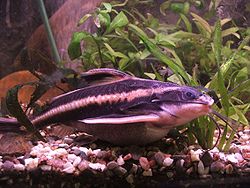- Doradidae
-
Thorny catfishes 
Platydoras armatulus Scientific classification Kingdom: Animalia Phylum: Chordata Class: Actinopterygii Order: Siluriformes Superfamily: Doradoidea Family: Doradidae
Bleeker, 1858Genera[2] Acanthodoras
Agamyxis
Amblydoras
Anadoras
Anduzedoras
Astrodoras
Centrochir
Centrodoras
Doraops
Doras
Franciscodoras
Hassar
Hemidoras
Hypodoras
Kalyptodoras
Leptodoras
Lithodoras
Megalodoras
Merodoras[1]
Nemadoras
Opsodoras
Orinocodoras
Oxydoras
Physopyxis
Platydoras
Pterodoras
Rhinodoras
Rhynchodoras
Scorpiodoras
Trachydoras
WertheimeriaDoradidae is a family of catfishes also known as thorny catfishes or talking catfishes. These fish are native to South America, primarily in Brazil, Peru, and the Guianas.
Doradids are omnivorous.[3]
Contents
Taxonomy
As of 2007, there are 31 genera and 78 species in this family.[1] Wertheimeria is considered to be the sister taxon to all other doradids.[4] This family is monophyletic and contains the subfamilies Platydoradinae, Doradinae, and Astrodoradinae, though their relationships are mostly unresolved.[5] Astrodoradinae contains the genera Amblydoras, Anadoras, Astrodoras, Hypodoras, Merodoras, Physopyxis, and Scorpiodoras.
Distribution
Doradids occur in most South American basins, though they are absent from the Pacific coast drainages and from coastal drainages south of the Río de la Plata.[4] 70% of the valid species occur in the Amazon basin; the Orinoco basin harbors about 22 species and ranks second in species richness.[4] On the other hand, only two species of doradids have been described from Brazilian eastern coastal basins: Wertheimeria maculata from the Jequitinhonha and Pardo rivers and Kalyptodoras bahiensis from the Paraguaçu River.[4]
Appearance and anatomy
Doradids are easily recognized by a well-developed nuchal shield in front of the dorsal fin as well as well-developed bony lumps along the lateral line that form thorny scutes.[1] Also, doradids typically have three pairs of barbels (no nasal barbels), an adipose fin, and 4–6 rays on the dorsal fin with a spine on the anterior (first) ray.[6] These fish are sometimes called "talking catfish" because of their ability to produce sound by moving their pectoral spine or vibrating their swim bladder.[6] Sizes range from 3.5 centimetres (1.4 in) SL in Physopyxis lyra to 120 centimetres (47 in) FL and 20 kilograms (44 lb) in Oxydoras niger.[4]
See also
References
- ^ a b c Higuchi, Horácio; Birindelli, José L. O.; Sousa, Leandro M.; Britski, Heraldo A. (2007). "Merodoras nheco, new genus and species from Rio Paraguay basin, Brazil (Siluriformes, Doradidae), and nomination of the new subfamily Astrodoradinae" (PDF). Zootaxa 1446: 31–42. http://www.mapress.com/zootaxa/2007f/zt01446p042.pdf. Retrieved 2009-06-24.
- ^ Ferraris, Carl J., Jr. (2007). "Checklist of catfishes, recent and fossil (Osteichthyes: Siluriformes), and catalogue of siluriform primary types" (PDF). Zootaxa 1418: 1–628. http://silurus.acnatsci.org/ACSI/library/biblios/2007_Ferraris_Catfish_Checklist.pdf. Retrieved 2009-06-24.
- ^ Milhomem, Susana Suely Rodrigues; de Souza, Augusto Cesar Paes; Nascimento, Aline Lira do; Carvalho, Jaime Ribeiro, Jr.; Feldberg, Eliana; Pieczarka, Julio Cesar; Nagamachi, Cleusa Yoshiko (2008). "Cytogenetic studies in fishes of the genera Hassar, Platydoras and Opsodoras (Doradidae, Siluriformes) from Jarí and Xingu Rivers, Brazil". Genetics and Molecular Biology 31: 256–260. doi:10.1590/S1415-47572008000200017.
- ^ a b c d e Eler, Eduardo S.; Dergam, Jorge A.; Vênere, Paulo C.; Paiva, Lílian C.; Miranda, Gabriela A.; Oliveira, Alessandro A. (2007). "The karyotypes of the thorny catfishes Wertheimeria maculata Steindachner, 1877 and Hassar wilderi Kindle, 1895 (Siluriformes: Doradidae) and their relevance in doradids chromosomal evolution" (PDF). Genetica 130 (1): 99–103. doi:10.1007/s10709-006-0023-4. PMID 16897457. http://www.springerlink.com/content/juh5755520758321/fulltext.pdf. Retrieved 2009-06-24.
- ^ Moyer, Gregory R.; Burr, Brooks M.; Krajewski, Carey (2004). "Phylogenetic relationships of thorny catfishes (Siluriformes: Doradidae) inferred from molecular and morphological data". Zoological Journal of the Linnean Society 140 (4): 551–575. doi:10.1111/j.1096-3642.2004.00114.x.
- ^ a b Nelson, Joseph S. (2006). Fishes of the World. John Wiley & Sons, Inc. ISBN 0-471-25031-7.
External links
- The Family Doradidae or "Talking Catfishes" Article on Scotcat.com by Chris Ralph
This Doradidae article is a stub. You can help Wikipedia by expanding it.
